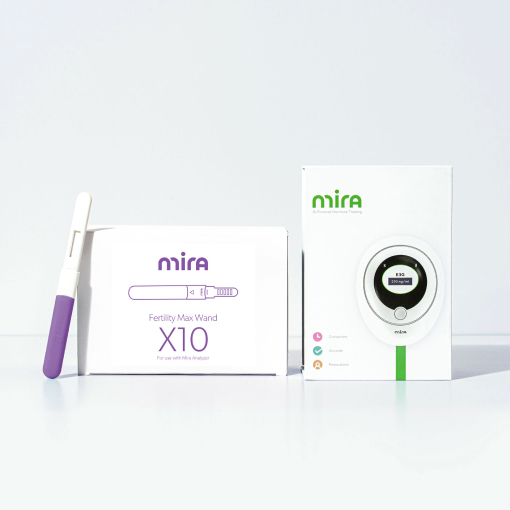Decoding Pregnancy Test Results: Evaporation, Indent, and Faint Lines
When you’re trying to get pregnant, you may feel eager, excited, and anxious when taking pregnancy tests. You want to see an easy-to-read result – but unfortunately, the reality of taking pregnancy tests is that the results can sometimes be challenging to interpret.
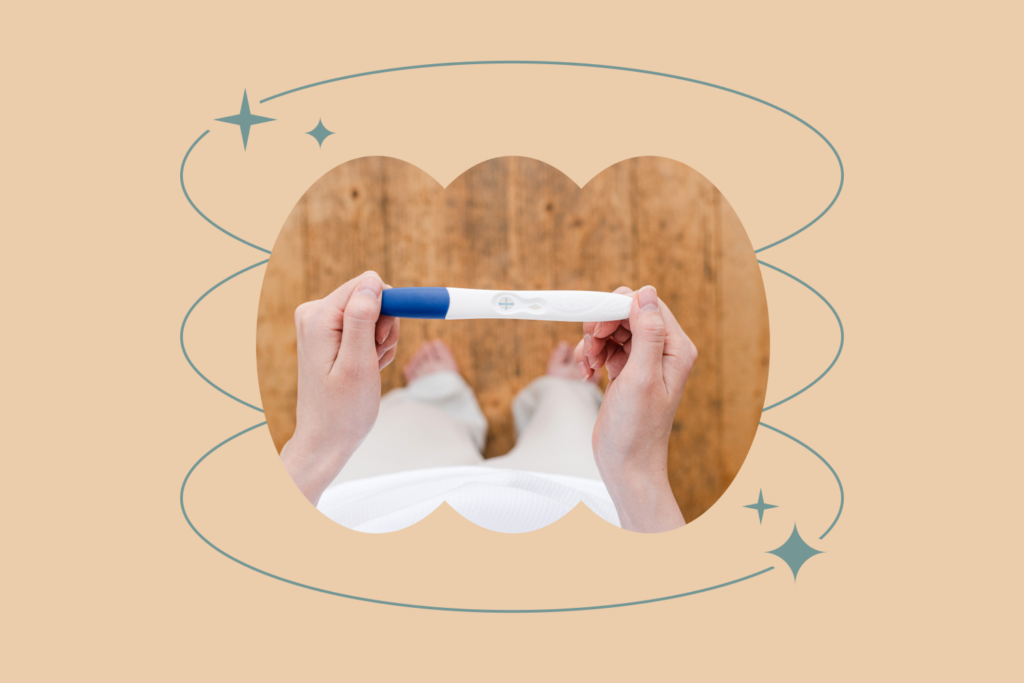
Faint lines, evaporation lines, indent lines, and more can put a damper on your pregnancy testing experience. Instead of getting excited about the results, you may find yourself confused or disappointed by a difficult-to-read result.
This blog post will teach you how to make sense of confusing pregnancy test lines — including faint lines, evaporation lines, and indent lines — so you can go into your pregnancy testing experience feeling confident and capable of interpreting your test.
The Different Types of Pregnancy Tests and How They Work
Home pregnancy tests use the concentration of the pregnancy hormone hCG (human chorionic gonadotropin) found in urine to determine whether or not you are pregnant. They do this by comparing your hCG levels to an average threshold of hCG found in early pregnancy.
Most pregnancy tests show two lines: a control line and a test line. The control line appears to show that you have tested properly, while the test line appears only if the test determines that you are pregnant. These lines are called “indents,” where the ink pools into one or two lines to show if you are pregnant or not.
You generally have the choice between three types of home pregnancy tests: mid-stream, dropper, and dip tests.
- Mid-stream tests are held in your urine stream for several seconds (after it has already started).
- Dropper tests use a dropper to extract fresh urine from a cup, which is poured inside the testing well.
- Dip tests use test strips that are directly submerged into a cup of collected urine.
For each of these options, it’s important to read the instructions and follow them closely for an accurate result. Often, you must wait a few minutes before the pregnancy test shows a result.
You should also make sure to take a pregnancy test at the right time — typically two weeks after the date of ovulation (read more about how to use ovulation test strips correctly) — to ensure you do not receive a false-positive or false-negative result.
After a few minutes, you can look at the test window to determine the result of your pregnancy tests.
Some newer, digital pregnancy tests use a plus or minus sign, or words like “yes” or “pregnant” to make the results less confusing. However, most pregnancy tests use a test line and a control line. When the test line is faint or evaporated, it can be challenging to determine whether you are actually pregnant.
Understanding Pregnancy Test Results
Pregnancy tests try to make the testing process as simple as possible. Unfortunately, some confusion when interpreting the results is unavoidable — especially if your test line comes back light or faint.
Here’s what you need to know about making sense of the different types of lines that can appear on a pregnancy test result.
Positive Test
A positive pregnancy test indicates that there is a 98-99% chance that you are pregnant. This means that your hCG levels are above the average threshold found in early pregnancy.
What it looks likes
Some of the symbols that might be used to indicate a positive test result include:
- The word “yes” or “pregnant”
- A smiley face
- A plus sign
- Two dark lines, either parallel or in the shape of a plus sign
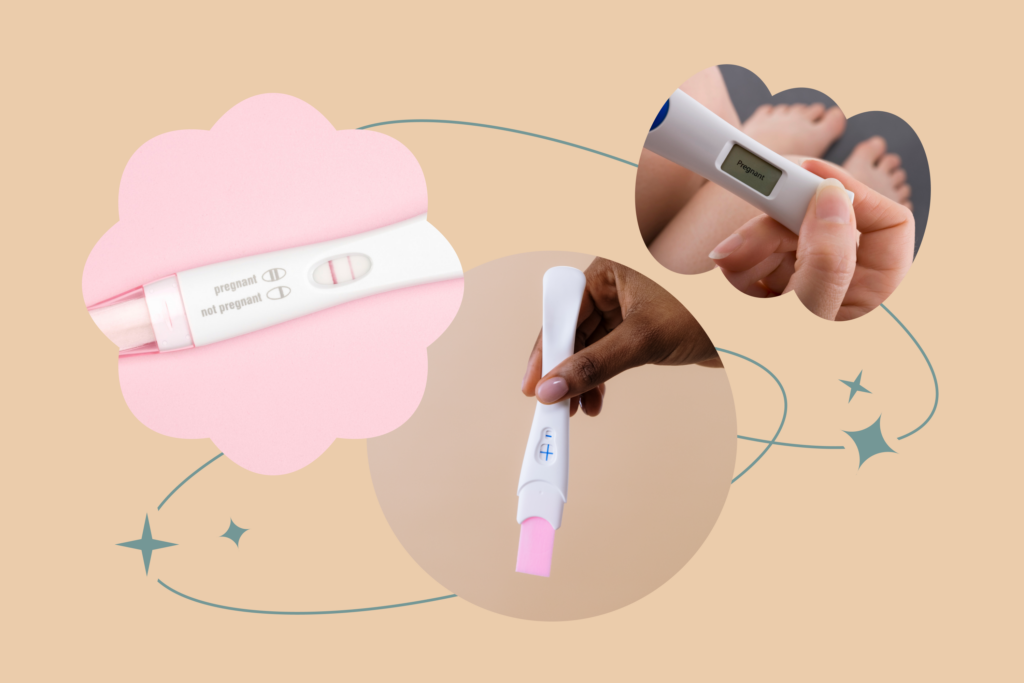
When these symbols appear, you can feel confident that, as long as you have tested at the right time and followed the directions, you are likely pregnant. Your doctor can follow up with an hCG blood test to confirm the result of the home pregnancy test.
Negative Test
A negative pregnancy test indicates that your hCG levels are not above the average threshold found in early pregnancy – meaning you are most likely not pregnant.
What it looks likes
Some of the symbols that might be used to indicate a negative test result include:
- The word “no” or “not pregnant”
- One dark line
If you have tested at the right time and received a negative result, you are most likely not pregnant.
If you continue to test negative while also missing subsequent periods, make an appointment with your doctor. They can help you investigate any underlying health issues that may be interfering with your test results.
What’s next? How to increase your chances of conception
Negative results can be frustrating – but there is still hope! Here are just a few different strategies you can try to help increase your chances of conception in your next cycle.
- Maintain a healthy pre-pregnancy lifestyle – this includes getting at least 7 hours of sleep each night, limiting stress, eating a well-balanced diet, and taking time to exercise each week.
- Have sex with your partner at the right time each cycle – this can be done with the help of natural family planning techniques or direct hormone tracking with Mira.
- Try fertility supplements such as prenatal vitamins.
Here is a handy checklist with everything you need to know about improving your chances of conception and preparing for a healthy pregnancy.
Please note: if you have been struggling to conceive for at least 12 months (or six months if over the age of 35), it is recommended to seek additional support from your doctor.
Indent line
Indent lines are the two lines — the control line and the test line — that fill with ink when you take a pregnancy test. They are named this way because they are slightly indented so the ink will not spill out.
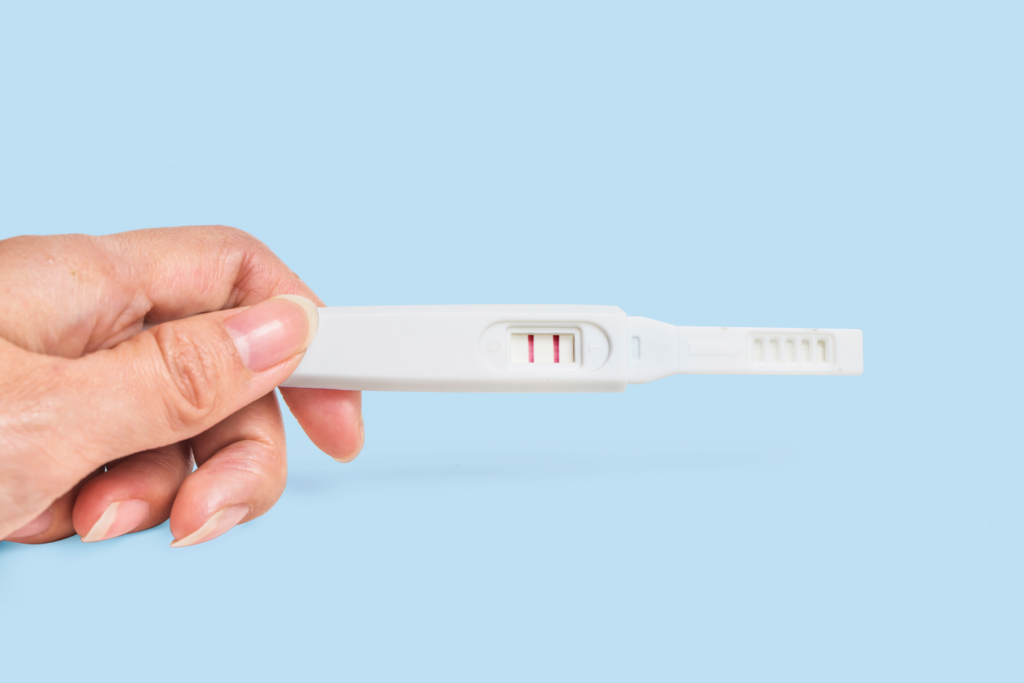
Causes of indent lines
Sometimes, as the ink moves across the test window, a small amount of ink gets stuck in the second indent line (the test line). As the pregnancy test begins to dry, your urine starts to evaporate, pulling the small amount of stuck ink up to the top of the line. This can result in a faint evaporation line or a false-positive result.
For this reason, it’s especially important to read the directions on the pregnancy test, particularly when it comes to how long you should wait. Set a timer so that you do not accidentally wait too long before interpreting the results, and make sure you keep the pregnancy test flat while it dries so that the ink will not fill the indent line and give you a false-positive result.
How to interpret indent lines
When you are pregnant, both indent lines will fill; if you are not pregnant, only the control line will fill. If neither line fills, it is an indication that the pregnancy test was either taken incorrectly or is defective, and you should repeat the test.
Faint line
Sometimes the test line on a pregnancy test appears faded or faint in color. While this could mean that you are pregnant, it could also indicate other health concerns.
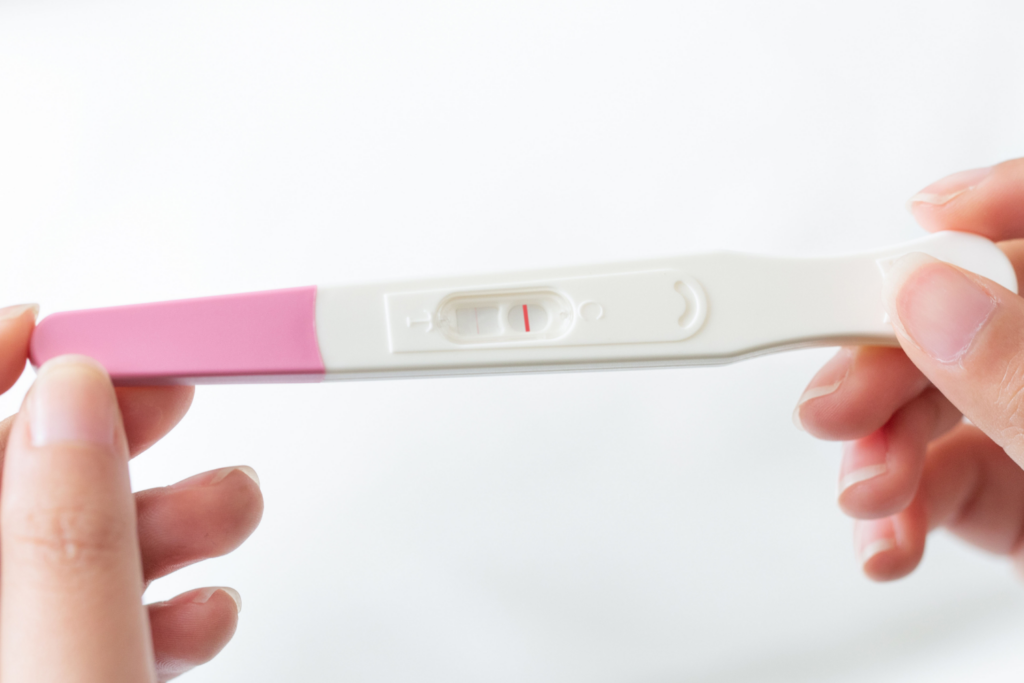
Causes of faint lines
In early pregnancy, your hCG levels rise gradually. A faint line could be the result of hCG levels that are rising, but not very far above the threshold to indicate that you are pregnant.
However, it may also be the result of a chemical pregnancy, a false-positive test result that comes from taking a pregnancy test too soon before the start of your next menstrual period.
Occasionally, faint lines on a pregnancy test can be due to health issues such as ectopic pregnancy, pituitary gland tumors, or ovarian cysts. If you continue to see faint lines when you repeat a pregnancy test, visit your doctor for an hCG blood test. Your doctor can then determine whether or not you are pregnant and rule out any serious medical conditions.

How to distinguish from evaporation lines
Distinguishing faint lines from evaporation lines comes down to timing and color. A faint line will appear within the recommended window of time when you can check your results (usually within three to five minutes after taking the test). It will also activate the dye in the pregnancy test, so it can appear blue or light pink in color.
Evaporation lines, on the other hand, occur after the testing window when the urine has dried up. This does not activate the dye in the test, so evaporation lines often appear colorless or translucent.
To avoid confusion, always make sure to read and follow each pregnancy test’s instructions closely.
How to interpret faint lines
Occasionally, a faint line on a pregnancy test means that you are pregnant. Other times, it may indicate a false-positive result. Usually, the cause of a faint line on a pregnancy test is the result of testing too early.
The best thing to do if you see a faint line on a pregnancy test is to wait and test again. If you are pregnant, testing again in two weeks should result in a darker, clearer test line, since your hCG levels will continue to rise. If the faint line was the result of a chemical pregnancy test, you may receive a negative test result when you test again.
Evaporation line
When the test line is visible but colorless, this is called an “evaporation line”. Evaporation lines rarely indicate pregnancy and are considered a false-positive result.
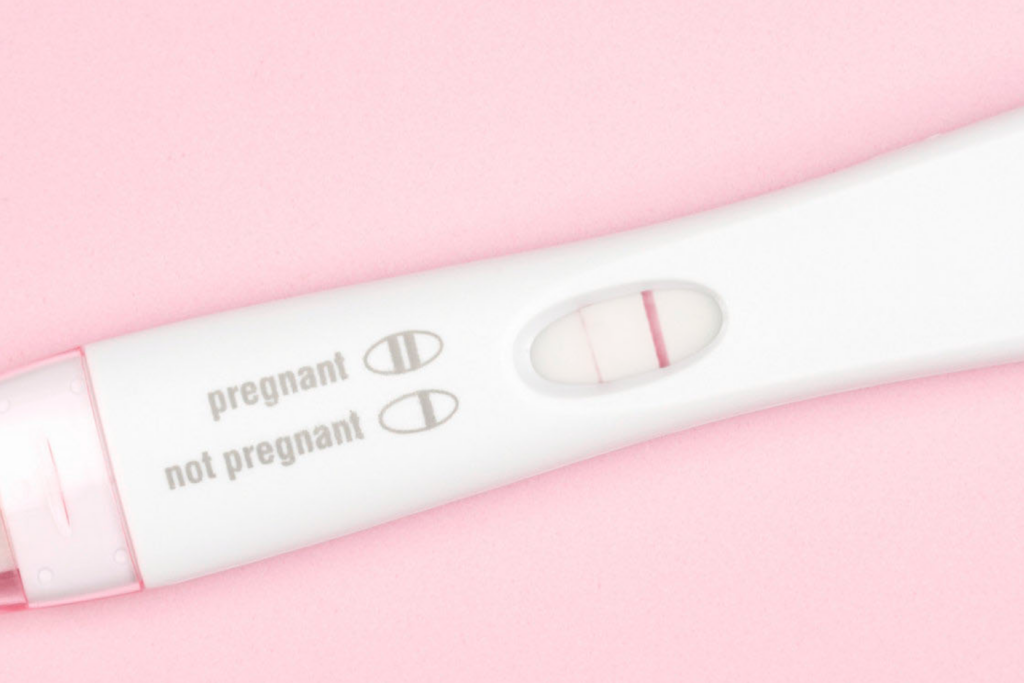
How evaporation lines occur
Pregnancy tests have a reaction time — a period of approximately three to five minutes after they’re taken when the urine used in them is still damp. The test result then appears after this three to five-minute window. However, if you wait too long after the reaction time to interpret the result, the urine in the pregnancy test can dry up, resulting in an evaporation line.
Evaporation lines may also occur if the test gets wet or is taken incorrectly.
How to distinguish from true positive results
Unlike a faint positive result, which will result in a light pink or blue line, an evaporation line does not activate the dye in the pregnancy test. This means that it may show up as a colorless or translucent line.
Anytime you see a faint line and are unsure if it means you are pregnant or not, the best thing to do is to repeat the pregnancy test with a new test strip.
False-positive
When the test line appears but you are not pregnant, this is considered a false-positive result. False-positive results are typically faint in color or colorless, and they can be difficult to interpret.
Causes of false-positives
One of the most common causes of false-positive results is user error. For example, testing too soon, not following the test instructions, or reading your result after the three to five-minute testing window has passed can all lead to a false-positive.
Other potential causes of a false-positive result include:
- Chemical pregnancy
- Ectopic pregnancy
- Molar pregnancy
- Recent miscarriage
- Certain medications, particularly fertility medications
- Certain medical conditions, such as urinary tract infections (UTIs), ovarian cancer, and kidney disease
If you continue to receive false-positive results across multiple cycles, it’s a good idea to speak with your doctor to determine if you have an underlying medical condition.
How to avoid false-positives
The best way to avoid false-positives is to follow the test instructions closely. Remember – each pregnancy test has its own set of instructions, so make sure to pay attention to things like when to take the test, how to take the test, where to place the test while you wait, and how long you should wait for your results.
What to do if you get a false-positive result
If think your result is a false-positive, the best thing to do is simply take another test. If the second test appears light or faint in color again, take another test in a few days when your hCG levels may be higher.
Again, if you continue to receive false-positive results, speak with your doctor. They can better assess your situation and conduct further testing if necessary.
False-negative
When no test line appears but you are in fact pregnant, this is considered a false-negative result.
Causes of false-negatives
False-negative results typically occur when the test has been taken too early – for example, in cases where ovulation actually occurred later in the cycle than previously estimated.
Many pregnancy test manufacturers also claim that too much liquid in your system may also lead to a false-negative result. This is because the liquid can dilute hCG levels in urine, making it difficult to detect.
Certain medical complications can also lead to a false-negative result. This includes ectopic or molar pregnancies.
How to avoid false-negatives
To avoid a false-negative result, always make sure to follow the test instructions closely. It is also recommended to always test with morning urine when hCG levels are the most concentrated.
What to do if you get a false-negative result
If you think your result is a false-negative, wait a few days and test again when your hCG levels could be higher.
If you are experiencing symptoms of early pregnancy but continue to receive a negative pregnancy test result, it’s a good idea to make an appointment with your doctor or OBGYN. This is especially true if your early pregnancy symptoms are accompanied with pain, nausea, or sudden vaginal bleeding.
Take the Quiz!
Tell us your fertility goal and we'll give you a perfect product match
Tips on Preventing False Positives or Negatives
When taking a pregnancy test, it’s important to follow the directions exactly to avoid getting a false-positive or false-negative result. Taking a home pregnancy test incorrectly is one of the most common causes of confusing test results. Follow these practical tips, in addition to the directions for your specific pregnancy test, to reduce the likelihood of false positives or false negatives:
Don’t Test Too Early
Wait at least two weeks after the day of ovulation, or one day after the date of your expected period, to increase accuracy. Taken at this time, home pregnancy tests are up to 99% accurate. You can pinpoint the day of your ovulation with greater accuracy using a digital fertility tracker like Mira.
Test More Than Once
Test more than once, especially if you are confused by the results of your pregnancy test. More than one positive pregnancy test result makes it more likely that you are actually pregnant, rather than receiving a false-positive result.
Test in the Morning
Take the pregnancy test using your first urine of the morning. Your hCG concentrations are the highest first thing in the morning, so if you are pregnant, you will decrease the likelihood of a false-negative result by testing using your first urine of the day.
Follow the Instructions
Read the instructions prior to taking the test and follow them closely. Set a timer for the exact waiting period so you do not accidentally wait too long and see an evaporation line. Most pregnancy tests will also tell you to keep the test strip flat while you are waiting for the results.
Know That Not All Tests Are Created Equal
If you are confused by the results of your pregnancy test, try a different type of home pregnancy test. Some people find pink dye or blue dye easier to see. Others may prefer a digital pregnancy test that uses a word like “yes” or “pregnant” to give a clear result.
Check for Other Pregnancy Symptoms
Check for other pregnancy symptoms. Early pregnancy symptoms include breast swelling or tenderness, nausea or vomiting (“morning sickness”), and missed periods. Combined with a faint positive line, these symptoms make it more likely for you to be pregnant.
See Your Doctor
If you’re still concerned about home pregnancy test results, schedule an appointment with your doctor. You may be able to have blood tests done to see if your hCG levels rise. Hopefully, you’ll get the exciting answer you’re looking for.
Recommended for you
Navigate your fertility with peace of mind
FAQs
What is the best time of day to take a pregnancy test?
Early morning. This is when hCG levels are the most concentrated in urine, making them easier to detect with an at-home pregnancy test.
How long should I wait before interpreting test results?
Every pregnancy test is unique. However, the typical waiting time for most pregnancy tests is three to five minutes.
Can I get a false-positive result if I have never been pregnant before?
Yes. False-positive results can be caused by a number of reasons including testing too soon, waiting too long to read your results, and certain medical complications.
Can I get a false-negative result if I am pregnant?
Yes. Sometimes false-negative results occur even though you are pregnant. The most common causes of false-negative results include taking the test too early in your cycle or taking the test with too much liquid in your system.
Can medications affect pregnancy test results?
Yes. Certain medications can affect your pregnancy test results. If you are taking any medications, speak with your doctor and they can offer guidance on whether or not your medication could affect the results of at-home pregnancy tests.
Can medical conditions affect pregnancy test results?
Yes. Chemical pregnancies, molar pregnancies, and ectopic pregnancies can all affect your pregnancy test results. Other medical conditions that may interfere with your results include recent miscarriage, UTIs, ovarian cancer, and kidney disease.
How can I avoid mistakes when taking a pregnancy test?
To avoid mistakes and confusion, it’s important to thoroughly read and follow the instructions for each pregnancy test. Remember – each pregnancy test is different so instructions can vary.
What should I do if I get an evaporation line?
If you suspect that your positive result is an evaporation line, you should take another test; making sure to follow the instructions closely.
What should I do if I get a faint line?
If your test line is faint, wait a day or two before testing again. This gives your hCG levels time to rise to a level where they can be detected by a pregnancy test.
What should I do if I get an indent line?
If both indent lines are filled and appear dark in color, this indicates that you are most likely pregnant. To confirm your pregnancy, it’s a good idea to have a blood test at your doctor’s office. They can then help you prepare for a healthy pregnancy.
What should I do if I get a false-positive result?
If you suspect that you have received a false-positive result, take another test. If you are still confused by your results, make an appointment with your doctor for further guidance.
What should I do if I get a false-negative result?
If you suspect that you have received a false-negative result, wait a few days and test again. This will help to ensure that your hCG levels are high enough to be detected by a pregnancy test.
What is the most reliable type of pregnancy test?
The most reliable type of pregnancy test is a blood test at your doctor’s office.
How accurate are home-based pregnancy tests?
When taken correctly, at-home pregnancy tests can be up to 99% accurate.
How soon can I take a pregnancy test after having unprotected sex?
Pregnancy tests should be taken no sooner than 12 days past ovulation (12 DPO). If you do not know your day of ovulation, wait until at least one day after the estimated start date of your next period.
Mira’s Editorial Process
All content produced by Mira meets stringent editorial standards, ensuring excellence and accuracy in language and medical precision. Every piece undergoes thorough fact-checking and review by qualified professionals. Check out our full editorial process to learn more.





